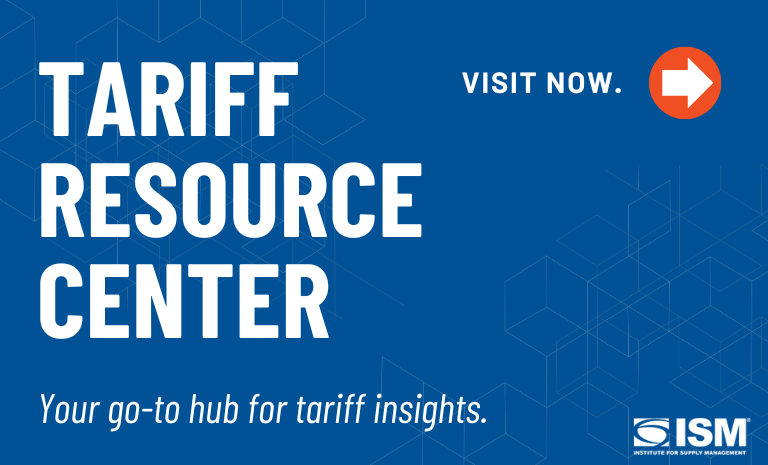ISM® PMI® Reports Roundup: September Manufacturing

As she began her media conference call on Wednesday, Susan Spence, MBA, Chair of the Institute for Supply Management® (ISM®) Manufacturing Business Survey Committee, noted that “other news is going on as we speak.”
The release of the ISM® Manufacturing PMI® Report for September occurred in Hour 10 of the federal government shutdown that began at midnight. It was one more potential hurdle for companies and supply managers that have been long beleaguered by tepid demand and tariffs turmoil, which was evident in the PMI® data and survey respondents’ comments.
The composite index registered 49.1 percent in September, a modest improvement. But that was primarily a product of a production boost that figures to be a blip, with new orders, inventories and backlogs contracting. And although the Prices Index (61.9 percent) fell to its lowest reading since January, there’s little relief: “Steel tariffs are killing us,” wrote a panelist in Miscellaneous Manufacturing.
“It’s a remarkably consistent picture that makes sense when you look at the data and especially the comments,” Spence said during the conference call. “If new orders are not flowing consistently, then production is going to stay in contraction, even though it flipped up (in September). Folks are loathe to hire and backfill because they are not sure what their customers are going to do. So, the (last few months) have been a consistent story.”
ISM Manufacturing up in September but still in contraction. New orders back in contraction but production back in expansion ... mixed bag @business pic.twitter.com/4NF3MncKtW
— Kevin Gordon (@KevRGordon) October 1, 2025
The slight increase in the PMI® was due primarily to the Production Index, which was up 3.2 percentage points to 51 percent. However, Spence said that’s likely the result of new orders growth in August that was short-lived.
In September, the New Orders Index dropped 2.5 percentage points to 48.9 percent, joining other demand gauges in contraction territory — the Backlog of Orders (46.2 percent) and New Export Orders (43 percent). With the Inventories Index (47.7 percent) also in contraction, that’s not a recipe for sustained production growth, Spence said.
The Employment Index (45.3 percent, up 1.5 points compared to August) remained in contraction but was not as eye-popping as the ADP private payrolls report on Wednesday: a decrease of 32,000 U.S. jobs in September and a revised August figure, a decline of 3,000. The ISM (with the Services PMI® on Friday) and ADP numbers could be the only employment data available this week, with the shutdown potentially delaying the federal jobs report release.
The big picture was summed up succinctly by a survey respondent in Transportation Equipment, who wrote, “We believe we are in a stagflation period where prices are up but orders are down due to tariff policy, and again, customers are not willing to pay the higher prices, so they are just not buying. Continuing to find ways to reduce overhead, which means letting go of experienced workers.”
Tariffs again dominated the respondent comments, and Spence said the hesitancy — from companies to invest capital and consumers to purchase — is not going to resolve itself. The Customers’ Inventories Index has been a positive for months, in “too low” territory suggesting that, at some point, companies will have to reorder.
US ISM'S SPENCE Q&A: MANUFACTURING SEES EMPLOYMENT DETERIORATION 'BEFORE ANYONE ELSE' AND 'THAT IS WHAT'S HAPPENING;' ENDS Q&A #Spence #ISM #manufacturing #economy
— Mace News (@MaceNewsMacro) October 1, 2025
But it’s not happening yet. The index continued to decline in September, down 0.9 percentage points to 43.7 percent, the lowest reading since January 2024 (43.7 percent). And with every passing month, Spence said on ISM’s LinkedIn Live broadcast on Wednesday, international buyers have incentive to look elsewhere than the U.S.
The soybean market has taken a big hit as China has stopped buying from American farms and sought alternative sourcing in South America. A similar buying shift could devastate manufacturing industries that are already limping: Only five of 18 industries reported growth in September, and large, critical ones like Chemical Products, Machinery, Transportation Equipment and Computer & Electronic Products contracted.
“Some panelists are clearly saying their customers are just not ordering,” Spence said. “To me, there’s a straight line from the economic policies and the uncertainty. I get the strategy, to make companies build factories in the U.S. But if there is an unknown about the future with tariffs and pricing, panelists are saying their companies’ capital plans are on hold.”
The interest-rate cut announced by the U.S. Federal Reserve will likely not spur investment because there’s simply too much uncertainty everywhere else. And that’s not going to change, Spence said on LinkedIn Live, until policymakers heed the months-long warnings from the manufacturing and purchasing communities.
“Eventually, data is the thing that has to be listened to,” she said.
The ISM® PMI® Reports roundup:
Bloomberg: U.S. Manufacturing Activity Contracts for Seventh Straight Month. “The report also showed manufacturers enjoyed a respite from inflationary pressures for raw materials. The (Prices Index) dropped for a third straight month, the longest such stretch since 2022, to 61.9 percent. That’s the lowest level since the start of the year, prior to the Trump administration’s implementation of tariffs. A further easing in input-price growth may temper price pressures for consumers.”
CNBC: ISM Manufacturing PMI® 49.1 vs. 49.0 Estimated. “(The Employment Index) — after a very weak ADP (private payrolls report) and questionable whether we’ll get the big (federal) jobs report on Friday — comes in at 45.3 percent,” analyst Rick Santelli said. “That’s better than expected, still in contraction territory but better than last month’s 43.8 percent.”
Mace News: Manufacturing ISM Weaker Overall as Tariff and Pricing Uncertainty Combines with Supply Chain Disruptions, Fewer Foreign Customers. “Capital investment plans are on hold, (Spence) said, and they ‘cannot be putting them on hold forever.’ Manufacturing tends to be first hit in an economic slowdown, a leading indicator of what’s in store for everything else, she said, even though the economy as a whole is still expanding.”
Manufacturing Dive: ‘Not a Good Sign.’ Weak Demand Continues Amid Tariff Uncertainty. “The federal government is partially shut down as of midnight Wednesday, adding to the economic uncertainty. Spence said impacts to each manufacturing sector depend on whether the sector relies on the federal government to approve their products or complete audits.”
MarketWatch: ‘We Believe We Are In A Stagflation Period:’ U.S. Manufacturers Stuck In Slump That Shows No Sign Of Ending. “(C)ompanies struggled to cope with high tariffs, rising prices and less demand from customers. Most manufacturers have responded by scaling back production plans and reducing employment to contain costs.”
Wow, probably the worst sentiment in a while - from the US #ISM #manufacturing survey - what respondents are saying: pic.twitter.com/19jbAU3r6I
— MacroTourist (@Gloeschi) October 1, 2025
Reuters: U.S. Manufacturing Eyes Recovery in September, Orders Contract. “Though production rebounded, factory employment remained depressed. The ISM has noted that "layoffs and not filling open positions remain the main head-count management strategies." Delivery times lengthened further last month, keeping prices paid by factories for materials elevated.”
The Wall Street Journal: U.S. Factory Activity Contracts at Slower Pace. “(T)he combined drops in the indexes for new orders and inventories exceeded the increase in the production index, rendering the overall improvement negligible, (Spence) said. … The index for prices remained in increasing territory, although losing pace from last month, the report said, while employment contracted, albeit at a slower pace.”
The ISM® Services PMI® Report will be unveiled on Friday. For the most up-to-date content on the ISM® PMI® Reports, use #ISMPMI on X, formerly known as Twitter.

